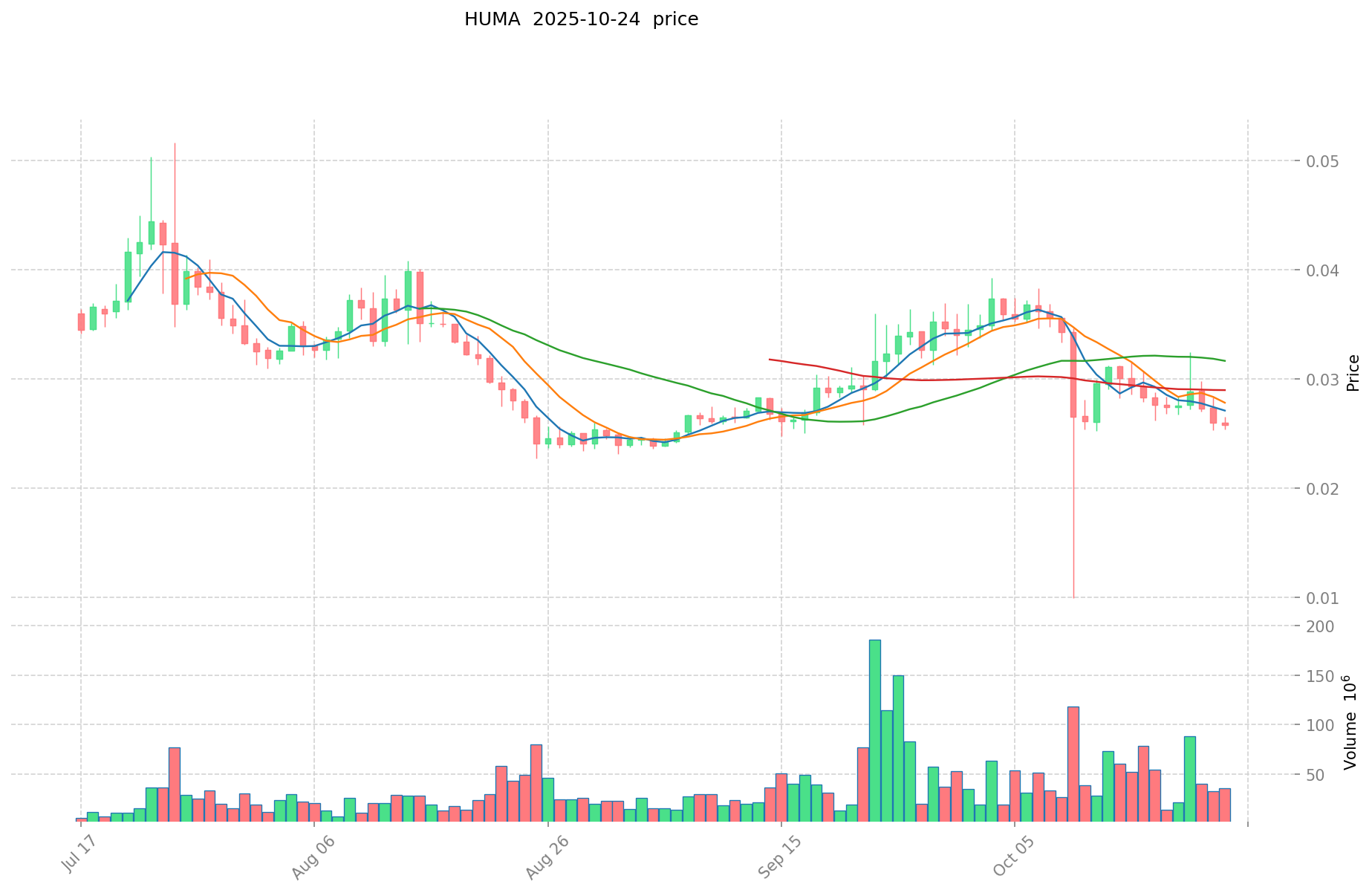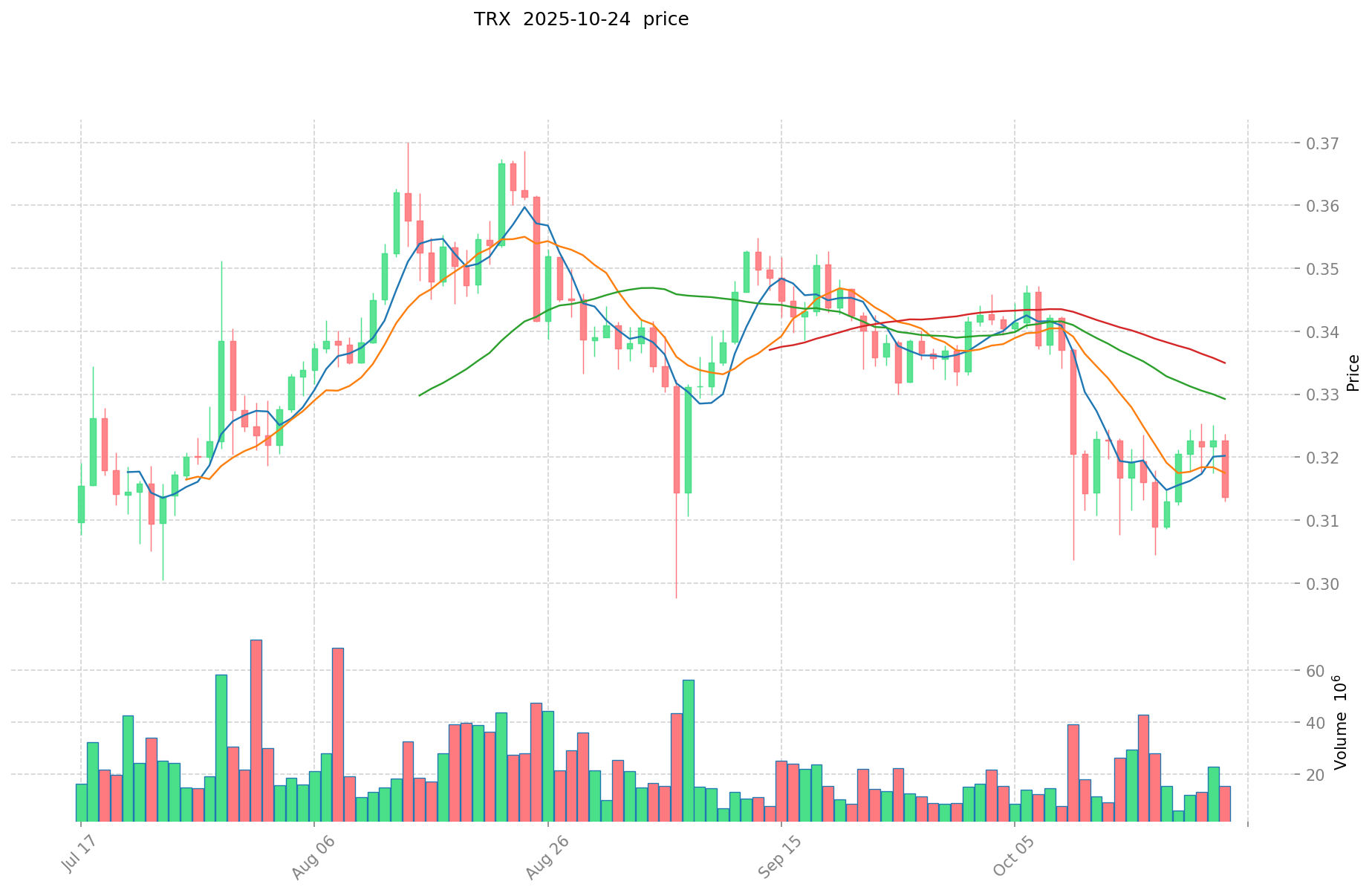HUMA vs TRX: The Battle of Fitness Equipment Giants Shaping Home Workouts
Introduction: Investment Comparison between HUMA and TRX
In the cryptocurrency market, the comparison between HUMA vs TRX has always been a topic that investors can't ignore. The two not only have significant differences in market cap ranking, application scenarios, and price performance, but also represent different crypto asset positioning.
Huma Finance (HUMA): Since its launch, it has gained market recognition for its positioning as a PayFi network supporting global payment financing.
TRON (TRX): Since its inception in 2017, it has been hailed as a large public chain that has entered into a partnership with a sovereign state to develop blockchain infrastructure, and is one of the cryptocurrencies with the highest global trading volume and market capitalization.
This article will comprehensively analyze the investment value comparison between HUMA vs TRX, focusing on historical price trends, supply mechanisms, institutional adoption, technological ecosystems, and future predictions, and attempt to answer the question that investors are most concerned about:
"Which is the better buy right now?" I. Price History Comparison and Current Market Status
HUMA (Coin A) and TRX (Coin B) Historical Price Trends
- 2025: HUMA reached an all-time high of $0.112, but subsequently dropped to $0.00989.
- 2024: TRX reached a yearly high of $0.44948, showcasing significant growth.
- Comparative analysis: In the recent market cycle, HUMA experienced a dramatic drop from its peak of $0.112 to its low of $0.00989, while TRX has shown more stability and maintained a higher price level.
Current Market Situation (2025-10-24)
- HUMA current price: $0.02556
- TRX current price: $0.31312
- 24-hour trading volume: HUMA $907,182 vs TRX $5,014,812
- Market Sentiment Index (Fear & Greed Index): 30 (Fear)
Click to view real-time prices:
- Check HUMA current price Market Price
- Check TRX current price Market Price


Investment Value Comparison: HUMA vs TRX Core Factors
Return Mechanism Comparison
- HUMA: Long-term stable high returns with potential yields reaching 30%+, enhanced by the HUMA Flywheel mechanism and token buybacks
- TRX: staking ETF system allowing investors to indirectly participate in TRON network staking rewards
- 📌 Historical pattern: High returns coupled with liquidity drive adoption and investor confidence
Institutional Adoption & Market Applications
- Institutional holdings: TRX's staking ETF innovation has enhanced its investment attractiveness for traditional financial institutions
- Enterprise adoption: HUMA positions itself as a core infrastructure provider in the PayFi sector, receiving support from VCs in the core ecosystem
- Market applications: HUMA has provided nearly $890 million in payment financing as of August 16, 2024, with 0% default rate
Technical Development & Ecosystem Building
- HUMA development: Implementing the HUMA Flywheel with three core components to enhance market confidence and provide sustainable returns
- TRX innovation: Introduction of staking mechanism through ETF format creates new revenue models accessible to traditional finance
- Ecosystem comparison: HUMA focuses on PayFi applications while TRX leverages its network for staking benefits
Liquidity & Risk Factors
- HUMA: Emphasizes flexibility with funds remaining accessible while providing returns
- TRX: Monthly price chart performance shows stability, suggesting potential benefits for long-term holders
- Market positioning: Both assets provide alternatives to high-risk contract trading, appealing to conservative investors seeking stable returns
III. 2025-2030 Price Prediction: HUMA vs TRX
Short-term Prediction (2025)
- HUMA: Conservative $0.0138 - $0.0256 | Optimistic $0.0256 - $0.0276
- TRX: Conservative $0.1940 - $0.3130 | Optimistic $0.3130 - $0.3599
Mid-term Prediction (2027)
- HUMA may enter a growth phase, with prices expected in the range of $0.0226 - $0.0420
- TRX may enter a consolidation phase, with prices expected in the range of $0.2042 - $0.4484
- Key drivers: Institutional capital inflow, ETF, ecosystem development
Long-term Prediction (2030)
- HUMA: Base scenario $0.0408 - $0.0453 | Optimistic scenario $0.0453 - $0.0540
- TRX: Base scenario $0.3245 - $0.5319 | Optimistic scenario $0.5319 - $0.5905
Disclaimer: This information is for educational purposes only and should not be considered as financial advice. Cryptocurrency markets are highly volatile and unpredictable. Always conduct your own research before making any investment decisions.
HUMA:
| 年份 | 预测最高价 | 预测平均价格 | 预测最低价 | 涨跌幅 |
|---|---|---|---|---|
| 2025 | 0.0276264 | 0.02558 | 0.0138132 | 0 |
| 2026 | 0.033786064 | 0.0266032 | 0.01729208 | 4 |
| 2027 | 0.04197053848 | 0.030194632 | 0.022645974 | 18 |
| 2028 | 0.0490723159264 | 0.03608258524 | 0.025257809668 | 41 |
| 2029 | 0.048112519159016 | 0.0425774505832 | 0.02980421540824 | 66 |
| 2030 | 0.053960531996618 | 0.045344984871108 | 0.040810486383997 | 77 |
TRX:
| 年份 | 预测最高价 | 预测平均价格 | 预测最低价 | 涨跌幅 |
|---|---|---|---|---|
| 2025 | 0.3598925 | 0.31295 | 0.194029 | 0 |
| 2026 | 0.464261325 | 0.33642125 | 0.25568015 | 7 |
| 2027 | 0.448382242 | 0.4003412875 | 0.204174056625 | 27 |
| 2028 | 0.500746882405 | 0.42436176475 | 0.2588606764975 | 35 |
| 2029 | 0.60132062065075 | 0.4625543235775 | 0.41629889121975 | 47 |
| 2030 | 0.590450594046678 | 0.531937472114125 | 0.324481857989616 | 69 |
IV. Investment Strategy Comparison: HUMA vs TRX
Long-term vs Short-term Investment Strategies
- HUMA: Suitable for investors focused on payment scenarios and ecosystem potential
- TRX: Suitable for investors seeking stability and inflation-resistant properties
Risk Management and Asset Allocation
- Conservative investors: HUMA 30% vs TRX 70%
- Aggressive investors: HUMA 60% vs TRX 40%
- Hedging tools: Stablecoin allocation, options, cross-currency portfolio
V. Potential Risk Comparison
Market Risk
- HUMA: Higher volatility due to smaller market cap and lower trading volume
- TRX: Susceptible to broader crypto market trends and regulatory news
Technical Risk
- HUMA: Scalability, network stability
- TRX: Hash power concentration, security vulnerabilities
Regulatory Risk
- Global regulatory policies may have differing impacts on both assets
VI. Conclusion: Which Is the Better Buy?
📌 Investment Value Summary:
- HUMA advantages: High potential returns, focus on PayFi sector, innovative HUMA Flywheel mechanism
- TRX advantages: Established ecosystem, staking ETF innovation, higher market cap and liquidity
✅ Investment Advice:
- New investors: Consider a balanced approach with a higher allocation to TRX for stability
- Experienced investors: Explore HUMA for higher potential returns while maintaining TRX for stability
- Institutional investors: Evaluate TRX's staking ETF system and HUMA's PayFi infrastructure potential
⚠️ Risk Warning: Cryptocurrency markets are highly volatile. This article does not constitute investment advice. None
VII. FAQ
Q1: What are the main differences between HUMA and TRX? A: HUMA is positioned as a PayFi network supporting global payment financing, while TRX is a large public chain with a focus on blockchain infrastructure. HUMA has a smaller market cap and higher volatility, while TRX offers more stability and liquidity.
Q2: Which coin has shown better price performance recently? A: TRX has shown better price performance recently, maintaining a higher price level and demonstrating more stability. HUMA experienced a significant drop from its all-time high but has potential for growth.
Q3: What are the key investment advantages of each coin? A: HUMA offers high potential returns and focuses on the PayFi sector with its innovative HUMA Flywheel mechanism. TRX benefits from an established ecosystem, staking ETF innovation, and higher market cap and liquidity.
Q4: How do the return mechanisms differ between HUMA and TRX? A: HUMA aims for long-term stable high returns with potential yields reaching 30%+, enhanced by its Flywheel mechanism and token buybacks. TRX offers a staking ETF system allowing investors to indirectly participate in TRON network staking rewards.
Q5: What are the price predictions for HUMA and TRX by 2030? A: For HUMA, the base scenario predicts $0.0408 - $0.0453, with an optimistic scenario of $0.0453 - $0.0540. For TRX, the base scenario predicts $0.3245 - $0.5319, with an optimistic scenario of $0.5319 - $0.5905.
Q6: How should investors allocate their assets between HUMA and TRX? A: Conservative investors might consider allocating 30% to HUMA and 70% to TRX, while aggressive investors might opt for 60% HUMA and 40% TRX. The allocation should be based on individual risk tolerance and investment goals.
Q7: What are the main risks associated with investing in HUMA and TRX? A: HUMA faces higher volatility due to its smaller market cap and lower trading volume. TRX is more susceptible to broader crypto market trends and regulatory news. Both face potential technical and regulatory risks.
Share
Content